Portarlington, Victoria
| Portarlington Geelong, Victoria | |||||||||||||
|---|---|---|---|---|---|---|---|---|---|---|---|---|---|
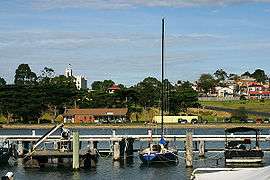 Portarlington seen from the town's pier | |||||||||||||
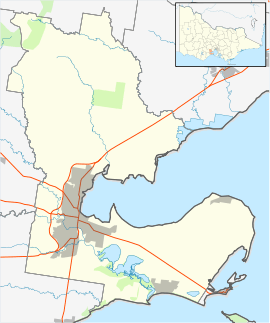 Portarlington | |||||||||||||
| Coordinates | 38°07′0″S 144°39′0″E / 38.11667°S 144.65000°ECoordinates: 38°07′0″S 144°39′0″E / 38.11667°S 144.65000°E | ||||||||||||
| Population | 3,580 (2011 census)[1] | ||||||||||||
| Postcode(s) | 3223 | ||||||||||||
| Location | |||||||||||||
| LGA(s) | City of Greater Geelong | ||||||||||||
| State electorate(s) | Bellarine | ||||||||||||
| Federal Division(s) | Corio | ||||||||||||
| |||||||||||||
Portarlington is a historic coastal township located on the Bellarine Peninsula, 28 km from the city of Geelong, in the state of Victoria, Australia. The gently rising hills behind the town feature vineyards and olive groves, overlooking Port Phillip Bay. Portarlington is a popular family holiday destination and a centre of fishing and aquaculture (mussels). At one time the town claimed the largest Fur Seal in the Southern Hemisphere, although the size of that beast has reduced considerably in recent decades. In the 2011 census, Portarlington (including Bellarine and the rural section of St Leonards) had a population of 3,580 people.[1] Portarlington also has a large number of Maltese, Croatian, Italian and Islander immigrants.
History
Early Inhabitants
The area around Portarlington was originally inhabited by the aboriginal Wathaurung people. Aboriginal shell middens can be found along the cliff-line at Portarlington. Mussels are the dominant shell species in evidence, demonstrating the importance of mussels to the area, even in pre-historic times. A ground-edged stone axe has been found at Portarlington. A stone artifact scatter also existed at a nearby site, but has been destroyed by development. Another stone artifact scatter has been identified at Point Richards, in the west of the town.
European discovery and exploration

The Port Phillip area was first significantly explored by Europeans in January 1802, when Lieutenant John Murray spent three weeks investigating the Bay entrance. He does not appear to have landed at Portarlington. Ten weeks later, the English explorer, Matthew Flinders, camped at Indented Head, 6 km to the south-east of Portarlington, where he traded with aborigines while undertaking a survey of the Australian coastline. He subsequently landed several times briefly on the peninsula coast to take bearings, including at the location of Portarlington (where he shared lunch with aborigines), and also at Point Richards. In February 1803, the Surveyor-General Charles Grimes landed from his ship, the Cumberland, at Portarlington with an expedition and spent several days exploring the Bay coastline to Point Cook. They were impressed by the fine pasture and soil in the Bellarine Hills. They sailed back from Point Cook to Portarlington and landed again, where they were met by aboriginals. They traded food and utensils, however other provisions were stolen from their boat in their absence. Some evidence of smallpox among the locals was noted at that time.
Apart from the likely wanderings of the escaped English convict, William Buckley, who lived among the Wautharong people around the Bellarine Peninsula for 32 years after escaping into the bush in 1803, there was little European contact with the area until the arrival of the pioneer settler, John Batman, and his Port Phillip Association expedition in 1835. Batman established a base camp at Indented Head, and proceeded to survey the interior of the peninsula. Batman wrote glowing reports of the pasture and grazing potential of the Bellarine Hills (which he named "Wedge's Range"), with a view of attracting interest in establishing sheep runs in the Port Phillip area. Further exploration was carried out by John Helder Wedge later in 1835, with Batman's encouragement, and Wedge is believed to have again passed through the vicinity of Portarlington. He was also much impressed by the countryside, which he named "Ballarine", but discovering the scarcity of fresh water, he directed his attentions elsewhere. When the first organised group of settlers arrived from Van Diemen's Land aboard the Enterprize in August 1835, they sought out the well-watered northern reaches of Port Phillip, around the Yarra River. Wedge and the Batman party quickly abandoned Bellarine and Indented Head and followed them there.
Settlement
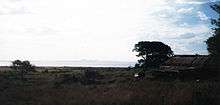
When the holdings of the Port Phillip Association were allocated, the Bellarine Peninsula was allotted to the member, John Sinclair, who was the Superintendent of the Engineers' Depot in Launceston. Sinclair was injured in February 1837, when he came to Port Phillip and attempted to visit his property. His two companions, Joseph Gellibrand and George Hesse, who continued the journey without him, disappeared, and no trace of them was ever found. Sinclair was evacuated back to Melbourne from Point Henry and made no further effort to take up his allotted land, although he remained in the Port Phillip District. By 1839 the Port Phillip Association had been bought out by the Derwent Company, which sold a number of runs on the Bellarine Peninsula and Indented Head to squatters, before folding in 1842.
Among the earliest known settlers in the vicinity of Portarlington was the former Hobart butcher, Henry Baynton, who was recorded there in the 1840s. Baynton established a cattle shipping service between Portarlington and Van Diemen's Land. He is believed to have had a station named Westham, which may have occupied a site near the derelict homestead now known as Lincoln's Farm, overlooking Point Richards. Baynton also had interests at Cowie's Creek (now Corio), across the Bay. Baynton possibly sold out to John Brown, who is identified as the owner of a Point Richards station in 1847. Other squatters known to have had property around the Portarlington area in the 1840s include William Booth, James Conway Langdon, and William Harding. In 1848 new land regulations were introduced, and the squatters' runs were subdivided into smaller allotments over the following years. By the early 1850s the era of the squatters had passed on the Bellarine Peninsula.
Growth of the early township

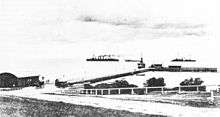
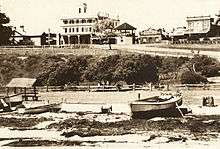
The township of Portarlington was formally surveyed around 1850 and was at that time named Drayton. It was renamed Portarlington in 1851, reportedly in honour of the English peer, Sir Henry Bennet, 1st Earl of Arlington, however it is also suggested, and perhaps seems more likely, owing to the number of early Irish settlers in the area, that the town was actually named after the town in Ireland bearing the same name, Portarlington, which was itself founded by Sir Henry Bennet in 1666. The newly surveyed township was neatly laid out, with broad streets, and planted with English elms and pines.
The first sale of town lots in Portarlington took place on 22 October 1851. It was described in the Geelong Advertiser newspaper as a "new township at Indented Head" and buyers were confident that it would quickly become "a place of importance". The first buyers were mainly speculators, so although the lots initially sold well, few purchasers settled on their lots, and the town was slow to fill.
A steam-powered flour mill opened in 1857, and after a competing mill in nearby Drysdale was destroyed by fire in 1861 the development of Portarlington began to progress more rapidly. The mill owners built a private jetty and began receiving grain shipments from Geelong, and returning processed flour and bran. Around this time, the Bellarine Peninsula was regarded as the granary of the Victorian colony. A Post Office opened on 1 March 1863 (incidentally, known as Port Arlington until about 1866 but this may have been in error).[2]
By 1865, the population of Portarlington had passed 200, and the town boasted two hotels and a blacksmith's shop. The Wesleyan congregation, who were the most numerous, built the town's first church in 1866. Before this they had conducted their services at the mill.
The Portarlington Pier was constructed in 1859, after a petition from local farmers demanding access to a public jetty, and it quickly became an important port of call for the network of steamers plying the Bay, both for goods and passengers. The first vessel servicing the direct run to Hobsons Bay, the Petrel, was reportedly doing a brisk trade by 1866, delivering hay, butter, eggs, cheese, potatoes, wheat, flour, geese, turkeys, poultry, bacon, pork, and pigs, and returning with supplies of tea, sugar, coffee, wine, beer, spirits, and other commercial items. The jetty was extended in 1870, allowing sufficient depth for shallow draft vessels to dock at any tide, and soon daily steamers from Melbourne were calling. The first to pick up passengers and cargo was the Despatch, in 1872. The direct run to Melbourne provided markets for large deliveries of potatoes and onions from around Portarlington, and lines of carts laden with produce were a common sight heading down to the port. At times up to eight or nine lighters would be loading at the jetty with cargo for Melbourne, as well as a steamer. The jetty was reconstructed in 1872, and storage sheds added.
Portarlington's picturesque setting and fine sandy beaches attracted visitors from Geelong and Melbourne, and the regular steamer service secured the town's progress as a popular seaside resort. A public bathing house existed from as early as 1868, and a replacement was built in 1877. Bathing on the open beaches was prohibited in early days "out of respect for public sentiment".
A brickworks was established in 1870, producing bricks, tiles, and pipes, from the high grade Portarlington clay, for local use, and was soon exporting to Geelong and Melbourne. When the flour mill closed down in 1874, the brickworks moved into the building. The brickworks seems to have ceased production during the depression in the 1890s.
There were 343 inhabitants in Portarlington in 1871.
The first State School in Portarlington (No. 1251) opened in the Wesleyan Church building in 1873, with 73 pupils. It was soon relocated to the Temperance Hall (built in 1874), after a dispute with church authorities. The new permanent red-brick school building, located on the current site, was formally opened on 27 Apr 1882, as State School No. 2455. It featured a bell-tower, a central fireplace, and two large rain-water tanks. A free public library opened in the ante-room of the Temperance Hall in 1883. A new and well-furnished building, purpose built for the library, was opened in 1884. A Market Reserve was established near the jetty in 1877.
The Anglican Church was built in Portarlington in 1883, and a Presbyterian Sunday school was constructed in 1888. The Catholic Church was completed in 1895, although it is believed that a Catholic school had been running in the town since the 1860s, and Mass may have previously been celebrated in a rented hall.
Horse racing began at Portarlington in 1859 on a track near the mill, but didn't generate much interest until the 1880s, when a new track was established to the west of the town. The new track was fenced-off in 1881, despite opposition from local graziers, and the Portarlington Turf Club was established in 1883, with an annual meeting held on Easter Monday. The track was close to the beach, and was knee-deep in sand in places. It was regarded as the heaviest track in the country.

The Portarlington Cricket Club was established in 1872, although the game had been played in the town for many years before. An Australian Rules Football club appeared in 1874. Tennis courts were built in the old park in 1896.
A permanent police station opened in Portarlington in 1875, although a trooper had been stationed in the town since 1871. The new station had no lock-up, so any prisoners had to be taken to Drysdale.
In 1887, a corner of the Market Reserve was allocated as the site for the new brick Post Office. Portarlington had enjoyed a postal service since the 1860s, however public agitation for a more centrally located facility had increased throughout the 1880s. A telegraph service began in 1882. A branch bank was also operating in the town by the 1880s. In 1882, Portarlington was described as an exceptionally clean town, with a variety of stores and traders, and a daily coach service ran to Geelong, via Drysdale. A rail service was also accessible from Drysdale. Five fishermen were operating out of the town at that time.
Twentieth Century and Beyond
By the 1920s, the increasing popularity of the automobile generated a new influx of holiday makers from Melbourne and regional Victoria. A number of camping grounds and caravan parks were established throughout the town, and in summer months the town's permanent residents were outnumbered many times over by holidaying families and tourists. Some families have been returning to Portarlington year after year, over multiple generations, some eventually buying holiday homes in the area, and they have become important contributors to the social and economic life of the town.
In more recent years the Seachange phenomenon has also made a notable impact on the town, with greater numbers of people buying property by the sea for lifestyle reasons or to enjoy their retirement. This has had a dramatic effect on property prices and has also lead to calls for improvements in services and infrastructure in the area.
Places of interest
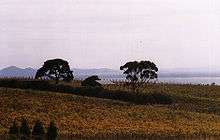
- The Portarlington Mill is a heritage site that houses a museum. The site is listed on the Victorian Heritage Register.[3]
- Portarlington Pier: Centre of economic and recreational activity in Portarlington.
- Portarlington Rotunda: Distinctive landmark in the centre of town.
- Tall Sailing Ship top sail schooner ENTERPRIZE'' docks at the Portarlington Pier Christmas/New Year period, Mussel Festival January and Celtic Festival June.(On board Celtic music by Richard Armstrong)
- Bellarine Hills: Portarlington's natural skyline, offering spectacular Bay views, wineries, olive groves, etc.
- Mussel Farms: A significant economic activity in Portarlington.
- Point Richards Flora and Fauna Reserve: A local haven for wildlife and native vegetation around the wetlands on the western edge of the town.
Festivals and events
- Bay Cycling Classic: Portarlington hosts a full day of events in this world-class criterium series held at select locations around Port Phillip Bay in the New Year.
- Portarlington Mussel Festival: food mostly mussles and festivities at Portarlington, the "Mussel Capital of Victoria", in mid January.
- Tarxien Social Club: Xalata ta' San Girgor (Saint Gregory): Maltese community gathering traditionally held over the Australia Day Weekend in January.
- Portarlington Triathlon: Described as one of the best courses in Australia, it is Victoria's oldest running triathlon event, and is held in late summer.
- Bellarine Agricultural Show: Variety of displays and activities held annually in March on the Portarlington Reserve.
- National Celtic Festival: National festival of Celtic folk music, dancing, and cultural activities held all around Portarlington in mid-year.
- Portarlington Market: Bustling market held around Parks Hall in Portarlington on the first Saturday in each month.
- Annual holiday destination with seasonal caravan parks attracting families mostly from Melbourne on the foreshore.
Sport
Portarlington has an Australian Rules football team competing in the Bellarine Football League.[4]
The town also fields teams in local cricket, tennis, and netball competitions.
Golfers play at the course of the Portarlington Golf Club on Hood Road.[5]
References
- 1 2 Australian Bureau of Statistics (31 October 2012). "Portarlington South (SSC)". 2011 Census QuickStats. Retrieved 9 July 2014.
- ↑ Premier Postal History, Post Office List, retrieved 2008-04-11
- ↑ "Portarlington Mill (H0389)". Victorian Heritage Register. Heritage Victoria. Retrieved 2014-03-26.
- ↑ Full Points Footy, Portarlington, archived from the original on 16 May 2008, retrieved 2008-07-25
- ↑ Golf Select, Portarlington, retrieved 2009-05-11
- Ian WYND, Balla-Wien: A History of the Shire of Bellarine, Shire of Bellarine (1988).
- Portarlington Indented Head Structure Plan, City of Greater Geelong (2006).
External links
| Wikimedia Commons has media related to Portarlington, Victoria. |
Community Groups
Events
- Bay Cycling Classic
- Portarlington Mussel Festival Official Website
- Portarlington Triathlon
- National Celtic Festival
- Bellarine Agricultural Show